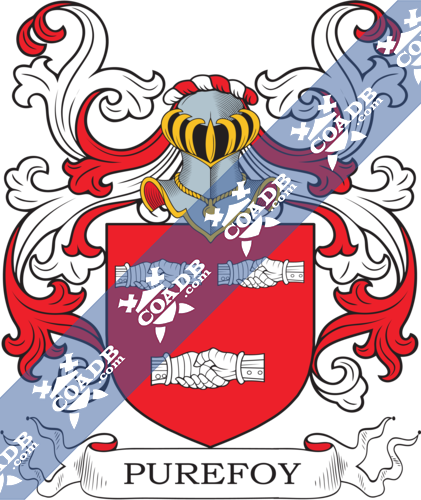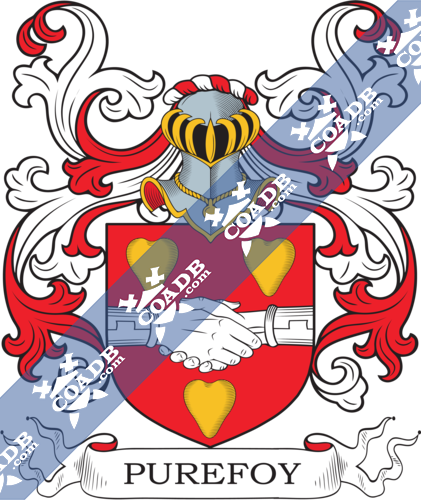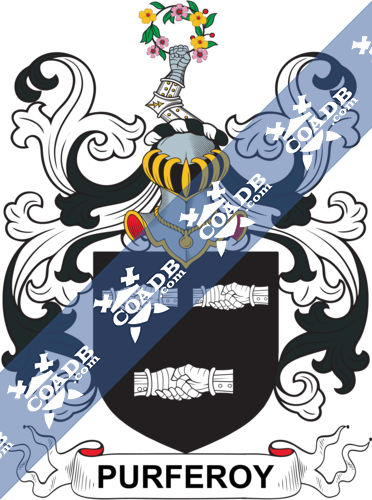Purefoy Family Crest, Coat of Arms and Name History

Purefoy Coat of Arms Gallery
Don’t know which Coat of Arms is yours?
We can do a genealogical research. Find out the exact history of your family!
Learn MoreThe old history of the name Purefoy started soon after 1066 when the Norman Invasion of England occurred. It was a name given to a man of true faith. The name originally acquired from the Old French pure-fay which meaning one who was staunch and true. It is only in the last few hundred years that the English language has standardised. For that reason, Anglo-Norman surnames like Purefoy are characterised by many spelling variations. Authors and priests in the Middle Ages spelt names they sounded, so it is common to find several variations that refer to a single person. As the English language changed and incorporated components of other European languages such as Norman French and Latin, even literate people regularly changed the spelling of their names. The variations of the name Purefoy include Purefoy, Purefield, Purefree, Purefrey, Purfrey, Purfry and much more. More common variations are: Puriefoy, Pureifoy, Purefoey, Purrefoy, Peurefoy, Purfoy, Purefy, Purifoy, Purofoy, Purefoi.
The surname Purefoy first discovered in Leicestershire where they held a family seat from very early times and granted lands by Duke William of Normandy, their liege Lord, for their distinguished assistance at the Battle of Hastings in 1066 AD.
Some of the people with the surname Purefoy who arrived in the United States in the 19th century included Thomas Purefoy, who settled in Virginia in 1621. Thomas Purefoy, who landed in Virginia in 1621. Lucy Purefoy, who landed in Virginia in 1629. Lucy Purefoy, who settled in Virginia in 1629. Samuell Purefoy, who settled at St. Christopher (New England) in 1633.
Blazons & Genealogy Notes
1) (co. Leicester). Gu. a saltire engr. ar betw. four mullets or.
2) Sa. three pairs of dexter hands conjoined or, ruffled ar. Crest—A demi talbot ramp. sa. ducally gorged or.
3) (Shadlestone, co. Bucks). Gu. three pairs of hands addorsed ar.
4) (Misterton and Drayton, co. Leicester; seated at the former place 1277, and at the latter 1397. The branches were Purefoy, of Barwell, Wolvershill, Shalleston, Wadley, &c.). Sa. six armed hands in pairs embracing, two and one ar. Crest—A dexter gauntlet or, the inside az. fingers grasping a broken tilting-spear of the second.
5) (Caldecote, co. Warwick; confirmed by Camden. Clarenceux, to William Pubefoy, Esq., of Caldecote, tenth in descent from Philip Purefoy, Esq., of Newnham, same co.). (co. Tipperary; descended from Michael Purefoy, Esq., of Caldecote, co. Warwick, escheater for that county, temp. Mary I., second son of Thomas Purefoy, Esq., of Drayton.) Sa. six armed hands in pairs embracing, two and one ar. Crest—In a dexter gauntlet ar. a broken tilting-spear or.
6) Gu. three pairs of hands couped hand in hand ar.
7) Gu. two arms issuing from the sides of the escutcheon, hand in hand ar. betw. three human hearts or (another adds, a crescent in fess).
8) (co. Kent). Sa. six armed hands clasped ar. Crest—A dexter hand holding a garland of flowers ppr.
9) (Bagwell-Purefoy, Greenfield, co. Tipperary; exemplified to Edward Bagwell, Esq., Lieut. 3rd Dragoon Guards, on his assuming, by royal licence, 1847, the additional surname of Purefoy, in compliance with the will of William Purefoy, Esq., of Greenfield). Motto—En bonne foy. Quarterly, 1st and 4th, sa. three pairs of hands conjoined, one and two or, ruffled ar., for Purefoy; 2nd and 3rd, paly of six ar. and az. on a chief gu. a lion of the pass, of the first, for Bagwell. Crest—A hand in armour grasping a broken lance all ppr.
10) (co. Kent). Sa. six armed hands clasped ar. Crest—A dexter hand holding a garland of flowers ppr.
11) Gu. two arms issuing from the sides of the escutcheon, hand in hand ar. betw. three human hearts or (another adds, a crescent in fess).

















